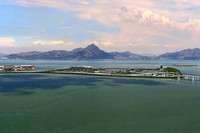 |
| No.6 September, 2009 |
|
| |
|
| |
Mega Bridge project reaches new stage |
|
| |
|
|
| |
 The Hong Kong project for Hong Kong - Zhuhai - Macao Bridge has reached a new stage with the Highways Department and Ove Arup and Partners Hong Kong Ltd signing an agreement for the detailed design of bridge’s Hong Kong Boundary Crossing Facilities Reclamation Works (September 17). The Hong Kong project for Hong Kong - Zhuhai - Macao Bridge has reached a new stage with the Highways Department and Ove Arup and Partners Hong Kong Ltd signing an agreement for the detailed design of bridge’s Hong Kong Boundary Crossing Facilities Reclamation Works (September 17).
On the other hand, measures proposed for the Hong Kong-Zhuhai-Macau Bridge's construction and operation have been deemed environmentally acceptable, the project's chief engineer Aaron Bok says.
Mr Bok describes the planning process as highly complicated, but notes the bridge will offer significant social and economic benefits to Pearl River Delta cities. |
|
| |
|
|
| |
When completed in 2015-16, the bridge will significantly reduce transportation time and costs for travellers and goods shipments on roads between the regions.
Travel time from Kwai Chung to Zhuhai will be slashed from three hours to an hour, and a journey from Hong Kong airport to Shenzhen Bay Port will be cut from 35 minutes to 20.
The environmental impact assessment covered the 130-hectare artificial island that will house the Hong Kong Boundary Crossing Facilities, the 12-kilometre Hong Kong Link Road and the 9km Tuen Mun-Chek Lap Kok Link.
Mr Bok said the construction - which will create 18,000 jobs in Hong Kong alone - will be "highly complicated" as it will involve reclamation and bridge construction over water. The construction sites will also be within the airport area and outside the Tung Chung New Town.
Strategic site selection
The consultants considered many factors before selecting a site for the Hong Kong Boundary Crossing Facilities which will be at the northeast waters off the Airport Island.
"Situated next to the airport, it will serve as a strategic transportation hub and create considerable synergy," Mr Bok said.
The location of the selected site will have less adverse impact on the Pearl River Delta's hydraulic, terrestrial and marine ecology, and water quality when compared to other sites.
Public concerns addressed
Mr Bok said plans for the Hong Kong Link Road have also been altered to accommodate Tung Chung residents' needs after they expressed grave concern on visual impact brought by a sea viaduct at the Tung Chung seafront.
Air and noise pollution are also of concern to nearby residents. Consultants conducted a robust quantitative air-quality assessment that simulated the regional air-quality effects in 2031, taking into account pollution sources in the Pearl River Delta such as power stations, the airport, marine vessels and road emissions.
They also assessed vehicular emissions in North Lantau and on Airport Island. The combined results indicate the cumulative air-quality impacts at these sites will comply with the legislation.
Construction-noise assessment results indicate that - after implementing good site practices, and quiet plant and mitigation measures - the noise impact will comply with the stipulated criteria.
Dolphin conservation key
The assessment also highlighted the potential impact on the Chinese White Dolphins' habitat.
"The government attaches great importance to preserving the dolphin ecology when planning the projects. Our aim is to minimise any impact on these creatures," Mr Bok said.
Engineers will take measures during construction to lessen the impact on the dolphins. These include avoiding percussive piling, using methods to minimise noise transmitted through the dredging and reclamation barges, and controlling construction vessels' speed limits.
"We will also adopt a dolphin watching plan. The Government will designate a marine park after the completion of the projects to enhance conservation of the marine habitat."
To avoid affecting the marine traffic, the Tuen Mun-Chek Lap Kok Link tunnel, about 5km long, will be built using the tunnel-boring-machine method rather than an immersed tube. This will also reduce seabed dredging and hence minimise effect on marine ecology.
"Though tunnel boring machine has been used in Hong Kong and world wide for years, this is the first time we deploy this construction method under the seabed at about 20m below sea level," he said.
"We target to commence the reclamation work in the third quarter of 2010." |
|
| |
|
|
|
| |
 |
|
|
| |
|
|
|
| |
|
|
|
|
 |

